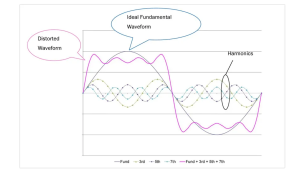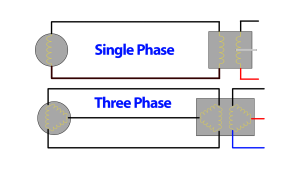Electromagnetic fields (EMFs) are everywhere in modern life. From the electricity that powers our homes to the wireless signals that keep us connected, we are constantly in the presence of EMFs. While their presence is largely beneficial. It is also important to understand their potential impact on the human body and whether or not they pose a danger to our health. The key factors that govern these interactions include frequency, voltage, and current.

Electromagnetic Fields and Radiation
Electromagnetic Fields (EMFs) are a combination of invisible electric and magnetic fields of force. They are generated wherever electricity is used – when we turn on a light, use an appliance, or charge a mobile device. They’re also produced by natural phenomena like sunlight and thunderstorms.
All electromagnetic waves vibrate and carry a certain amount of energy. This energy increases as frequency of the vibration increases. For frequencies above the visible light spectrum (ionizing radiation), such as ultraviolet radiation, X-rays, and gamma rays, there is an incredible amount of energy carried by these high-frequency waves. These waves are also produced in nuclear reactions which is why human exposure to nuclear radiation is so dangerous. This level of energy can penetrate human skin and can change the molecular structure of atoms and DNA.
Lower energy levels such as microwave, radio wave, and visible light radiation (non-ionizing) vibrate much lower frequencies and have far less energy associated with them. These waves do not have the energy to ionize atoms or molecules or cause harm to the human body. So exposure to them is considered far less dangerous.
What are Frequencies and Wavelengths
Before we dive into ionizing and non-ionizing radiation we need to understand what we mean when we use the terms “frequency” and “wavelength.” These terms both describe different aspects of wave behavior and are inversely related.
Frequency refers to the number of cycles a wave completes per second, measured in Hertz (Hz). Higher frequencies mean more cycles, or full oscillations, per second, while lower frequencies mean fewer cycles/oscillations per second. Example frequencies are:
- 1 Hz (1 Hertz = 1 cycle per second)
- 1 kHz (1 kiloHertz = 1,000 cycles per second)
- 1 MHz (1 MegaHertz = 1 million cycles per second)
- 1 GHz (1 GigaHertz = 1 billion cycles per second)
- 1 THz (1 TeraHertz = 1 trillion cycles per second)
- 1 PHz (1 PetaHertz = 1 quadrillion cycles per second)
- 1 EHz (1 ExaHertz = 1 quintillion cycles per second)
Wavelength is the distance between successive peaks of a wave and is typically measured in meters (m), centimeters (cm), or nanometers (nm). As the frequency of a wave increases, its wavelength decreases, and vice versa. This makes sense, because the more frequent a vibration happens, the least length there will be between each peak of the wave. Example wavelengths are:
- AM Radio: 535 kHz to 1.7 MHz (wavelengths of hundreds to thousands of meters)
- FM Radio: 88 MHz to 108 MHz (wavelengths of about 3.4 to 2.8 meters)
- Microwave Ovens: Around 2.45 GHz (wavelength of about 12.2 cm)
- Visible Light: 430 THz to 770 THz (wavelengths of about 700 nm for red light to 400 nm for purple light)
- Ionizing UV: Starts at frequencies > 2.42 PHz (wavelengths < 124 nm)
- X-rays: 30 PHz to 30 EHz (wavelengths of about 10 nm to 0.01 nm)
- Gamma Rays: Frequencies > 30 EHz (wavelengths < 0.01 nm)
So when we discuss ionizing radiation we’re talking about a specific band of energy levels in the upper UV band and higher, not the lower UV-A and UV-B bands commonly found from sunlight.
Ionizing Radiation
Ionizing radiation has enough energy to remove tightly bound electrons from atoms. This can cause atoms to become charged or ionized. X-rays and gamma rays are forms of ionizing radiation. When you think about it – the reason X-ray technicians leave the room during an x-ray (and why they cover you with a lead blanket), is to reduce exposure to this momentary ionizing radiation. Ionizing radiation can damage the cells of living organisms and their DNA. Which may lead to health problems such as cancer.

Ionizing radiation begins at the higher frequency end of the electromagnetic spectrum. Specifically, ionizing radiation starts in the ultraviolet (UV) range and extends into the X-ray and gamma ray regions. The starting point of ionizing radiation typically starts at the upper end of the UV range, at around 2.42 PHz with wavelengths less than 124 nanometers (nm). This is typically near where UV-C starts.
In sunlight, UV-A and UV-B radiation are dangerous over long exposure. This is because they can trigger melanin production at a cellular level, which is why the skin begins to darken. UV-A can penetrate deeper into the skin but at less energy levels. Whereas UV-B doesn’t penetrate as deep but can cause more skin damage (sun burn) as it has higher energy associated with it. Tanning beds and prolonged exposure to UV-A and UV-B can still be cancer causing. Even ocular exposure from looking directly at these lights can damage eye sight and create cataracts and vision loss. This is why wearing glasses and sunscreen outside are so effective. Sunscreen, depending on the type, can absorb this energy before making it to the skin or reflect the energy back outward.
Non-Ionizing Radiation
Non-ionizing radiation has less energy and cannot ionize atoms or molecules. It includes electricity, radio waves, and light from the visible spectrum. Non-ionizing radiation is generally perceived as safe, but there are still debates and ongoing research regarding its potential long-term health impacts.
AM and FM radio signals (535 kHz to 1.7 MHz) traverse the air at low energy levels, within the non-ionizing spectrum of the electromagnetic frequency spectrum. Bluetooth and WiFi (2.4 GHz to 5.825 GHz) signals are propagating the space around us constantly – but at energy levels far below the threshold of ionizing radiation.
Many people think 5G towers and satellite communications are ionizing, but this is also incorrect. Standard 4G cellular communications exist within the 600 MHz to 3.7 GHz band, with 5G existing from 24 GHz to 72 GHz range. Satellite communications operate within the 1-2 GHz range (L-band) up to the Ka-band 26.5-40 GHz range. These are still far too low of energy waves to harm humans – remember we need to be in the PetaHertz range for ionizing to occur. Gigahertz signals are in the billions of cycles per second, where PetaHertz are in the quadrillions.
Frequency, Voltage, and Current
The frequency of an EMF refers to the number of times the wave oscillates per second. Lower frequency fields, like those from electrical power lines, can cause currents within the body. At high enough levels, this can lead to nerve and muscle stimulation. However, these effects are usually only observed at exposure levels far beyond what most people would experience in daily life.
Higher frequency fields, like those from wireless devices, can result in energy absorption by the body, causing tissue heating. But again, these devices operate at levels far below what could cause a noticeable increase in body temperature.
The voltage and current of an EMF can affect its strength. Higher voltage power lines, for example, produce stronger fields than lower voltage lines or everyday household appliances. Still, the field strength decreases rapidly with distance, reducing potential exposure levels.
Wireless Signals and Household EMFs
When comparing the impact of EMFs from wireless signals to those in our homes, it’s important to note that they operate at different frequencies. Wireless signals, like those from our smartphones or Wi-Fi routers, operate at higher frequencies and can cause minor tissue heating at very high levels. However, manufacturers design these devices to operate well within safe limits, and normal use does not raise concerns about substantial heating.

EMFs from household electricity, on the other hand, operate at lower frequencies (50-60 Hz) and can induce small electrical currents within the body. As with wireless signals however, these fields are typically too weak to cause any noticeable effects in humans.
Health Risks and the Debate Around EMFs
Non-ionizing radiation from EMFs, especially those associated with wireless technology and power lines, have been the subject of extensive research. While some studies suggest a possible association between long-term, heavy use of wireless devices and certain types of brain cancer, the evidence is not strong enough to be considered conclusive.
The World Health Organization, among other health agencies, currently holds that wireless devices are safe for the general population. However, they also recommend reducing unnecessary exposure to EMFs when possible. You can minimize exposure by avoiding living directly under high voltage power lines or keeping wireless devices close to your body for prolonged periods. However the harm from walking outside and getting direct exposure to the sun is more of a concern than having a cellphone in your pocket or having wires in your walls near your pillow at night.
The Case of 5G
The fifth generation of wireless technology, or 5G, uses higher frequencies (up to 100 GHz) to deliver faster speeds and more reliable connections. Despite rumors and misconceptions, these frequencies are far below the threshold for ionizing radiation and do not have the energy to cause direct damage to DNA or cells.

5G networks do utilize more transmitters placed closer together, which could lead to increased exposure to radiofrequency radiation. However, each individual source is low power, and the overall exposure is still well within international safety guidelines. As of 2021, most research indicates that 5G does not pose a risk to human health.
In Conclusion
The current consensus among scientists and health organizations is that at typical exposure levels, EMFs from electricity and wireless technologies do not pose a significant risk to human health. Still, as our use of technology evolves and grows, ongoing research is critical to continue evaluating potential health effects over time.
To minimize potential risks, individuals can reduce their exposure to EMFs by maintaining distance from high-voltage power lines and reducing direct contact with wireless devices. As our understanding of EMFs continues to develop, staying informed about the latest research is essential for making knowledgeable decisions about our use of technology.
Check out the article “Magnetic Field vs Electric Field” next!








